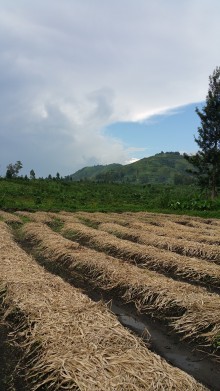Coffee Quality Manager Beth Ann Caspersen is currently in the Democratic Republic of the Congo to judge the country's first-ever coffee cupping competition. Here's part two of her updates from the field. Read part one here.

Today, coffee is once again becoming the cash crop of choice and is the primary source of income for many Congolese in the greater area of Minova. Here you can see jutting mountains that surround the lake, sparsely planted bananas, cassava and beans interlaced into the landscape. But the near death of the coffee sector which had once prospered, left the shambas (farms) in dire need of renovation, which has been both a cultural and an economic shift.
Many coffee farmers are resistant to uprooting old and unproductive coffee trees because it will mean that they will lose the small amount of coffee they had been receiving from that tree, only to wait for 3-4 years for their younger trees to produce. The return on investment by uprooting old trees or planting new trees on unused land will exceed the minimal income they are receiving from unproductive coffee trees in the years to come, but for a farmer that has only 700 trees on their shamba, it feels sacrificial; it affects their income in the short term and people have been afraid to do it. While this may seem like a challenge, many of the farmers can see the shifting coffee movement in the DRC and the farmers of SOPACDI co-op voted to use their Fair Trade premiums to support the infrastructure of the coffee processing stations and to build 14 coffee nurseries to raise coffee seedlings. All to be planted later on their own shambas.

Stay tuned for more from the DRC!
